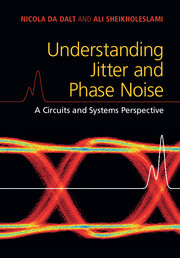Book contents
- Frontmatter
- Dedication
- Contents
- Preface
- Acknowledgments
- 1 Introduction to Jitter
- 2 Basics of Jitter
- 3 Jitter and Phase Noise
- 4 Jitter and Phase Noise in Circuits
- 5 Effects of Jitter in Synchronous Digital Circuits
- 6 Effects of Jitter on Data Converters
- 7 Effects of Jitter in Wireline Applications
- 8 Phase Noise in Wireless Applications
- 9 Advanced Concepts on Jitter and Phase Noise
- 10 Numerical Methods
- Appendix A Review of Random Variables and Processes
- Appendix B Matlab Code for Jitter Generation and Analysis
- Bibliography
- Index
Preface
Published online by Cambridge University Press: 19 February 2018
- Frontmatter
- Dedication
- Contents
- Preface
- Acknowledgments
- 1 Introduction to Jitter
- 2 Basics of Jitter
- 3 Jitter and Phase Noise
- 4 Jitter and Phase Noise in Circuits
- 5 Effects of Jitter in Synchronous Digital Circuits
- 6 Effects of Jitter on Data Converters
- 7 Effects of Jitter in Wireline Applications
- 8 Phase Noise in Wireless Applications
- 9 Advanced Concepts on Jitter and Phase Noise
- 10 Numerical Methods
- Appendix A Review of Random Variables and Processes
- Appendix B Matlab Code for Jitter Generation and Analysis
- Bibliography
- Index
Summary
This book provides a rigorous yet intuitive explanation of jitter and phase noise as they appear in electrical circuits and systems. The book is intended for graduate students and practicing engineers who wish to deepen their understanding of jitter and phase noise, and their properties, and wish to learn methods of simulating, monitoring, and mitigating jitter. It assumes basic knowledge of probability, random variables, and random processes, as taught typically at the third- or fourth-year undergraduate level, or at the graduate level, in electrical and computer engineering.
The book is organized as follows: Chapter 1 provides a qualitative overview of the book and its contents. Chapter 2 covers the basics of jitter, including formal definitions of various types of jitter and the key statistical concepts, starting from jitter mean and the standard deviation up to random and deterministic jitter. Phase noise will be first introduced in Chapter 3, and its relation to jitter and to the voltage spectrum of the clock signal will be extensively investigated. In particular, how to derive from phase noise the values of the several jitter types introduced previously will be explained. Chapter 4 is dedicated to the effects of jitter and phase noise in basic circuits and in basic building blocks such as oscillators, frequency dividers, and multipliers. Chapters 5 to 8 discuss the effects of jitter and phase noise in various circuit applications. Chapter 5 is dedicated to the effects of jitter on digital circuits, Chapter 6 to data converters, Chapter 7 to wireline, and Chapter 8 to wireless systems. More advanced topics on jitter are covered in Chapter 9, followed by numerical methods for jitter in Chapter 10. This chapter also explains how to generate jitter and phase noise, with various characteristics, for simulation purposes. The corresponding Matlab code for producing jitter is included in Appendix B.
As mentioned earlier, this book assumes the reader has a basic knowledge of random variables and random processes. However, to refresh the reader's memory of the definitions of some key terms, Appendix A simply lists these key terms along with their basic definitions.
Guidance for the Reader
The book does not require the reader to adhere strictly to the order in which the chapters appear, nor to read all of them.
- Type
- Chapter
- Information
- Understanding Jitter and Phase NoiseA Circuits and Systems Perspective, pp. xiii - xivPublisher: Cambridge University PressPrint publication year: 2018

